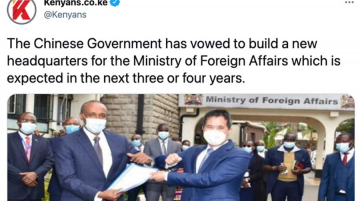
China’s Sinohydro Corporation and Engineering has received the green light to commence works on the $135 million Mwache Multipurpose Dam project in Kenya’s Kwale County.
Launched by President William Ruto on Thursday, the long-awaited project is scheduled for completion in 2026.
Construction works were delayed for five years following land disputes and concerns over the compensation of landowners and residents.
Once completed, the project will reduce Kenya’s reliance on rain-fed agriculture.
President Ruto said the dam would sustainably provide water for irrigating at least 7,000 acres of land. This size of land could produce food worth $9.7 million per year and create jobs for thousands of youths who are struggling to make a living in East Africa’s biggest economy.
The Kenyan government and the World Bank finance the project. The dam will supply over 230 million liters of water daily for irrigation and by households. An estimated 1.6 million people in Kwale and Mombasa Counties will benefit from the project.
Kenya has been on a dam-building spree with Ruto’s months-old administration having promised on the campaign trail to build dams to enable the country to tap into its agricultural potential. The government is continuing with the previous administration’s projects including the Thwake Multi-Purpose Dam whose works are being undertaken by the China Ghezoubha Group Company (CGGC).
Completion of the dam located between Makueni and Kitui counties was pushed to June 2024 early this year after delays similar to the Mwache dam.
In December 2021, CGGC diverted a section of the Athi, Kenya’s second-longest river, into two giant tunnels for excavation works to continue on the dam site. The 700-meter-long diversion tunnels were used to change the Athi River’s course to allow the construction of a rock field dam wall and the excess water flow spillways.
The Thwake dam, jointly funded by the Kenya government and the African Development Bank (AfDB), is being implemented in four phases at a cost of $613 million.
In addition to providing water for domestic use, livestock, and irrigation, the dam is also expected to generate hydropower which will be a boost to Kenya’s rally to provide reliable power.
Last year, the country launched the Thiba Dam in Rukenya, Kirinyaga County. German contractor, Strabag International Gmbh, did the dam.
Kenya Adapting to Cope With Climate Change Challenges
Kenya’s water resources are highly vulnerable to climate variabilities. This often leads to floods and droughts.
The country’s inadequate storage capacity limits its ability to buffer against the many water shocks and shortages.
With the current access to clean water in Kenya estimated at 90 percent in urban areas and 44 percent in rural areas, there remains a challenge in ensuring there is enough water for irrigation. This means that the country has suffered continuous food shortages in the dry seasons while in some cases the rainy seasons bring with them the destruction of food crops when it floods.
Kenya is “chronically water scarce” with water availability currently standing at 647m3 per capita. This is projected to fall to 245m3 per capita by the year 2025.
The move to build dams is one approach that will help the country address its water shortage issues. The government plans to build 100 large and 1,000 small dams and increase the acreage under irrigation from the current 670,000 to 3 million, according to President Ruto.
He adds that irrigation is the most transformational intervention for Kenya’s agriculture.
WHY IS THIS IMPORTANT? Kenya’s food insecurity has been a subject of concern for decades and with worsening weather patterns that are hitting the agricultural sector the hardest, the country is duty-bound to provide food through alternative agricultural practices away from reliance on rain-fed agriculture.
Building mega dams is enabling the country hit two birds with one stone since it can additionally generate power while also building its water management capacity which will help improve agricultural output.
SUGGESTED READING:
- ScienceDirect: Farmer-led irrigation development in Kenya: Characteristics and opportunities by Bancy Mati
- National Irrigation Authority: National Expanded Irrigation Programme







